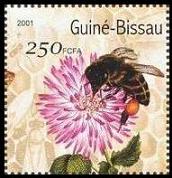In Brazil, imidacloprid is a widely used insecticide on agriculture and can harm bees, which are important pollinators. The active ingredient imidacloprid has action on the nervous system of the insects. However, little has been studied about the actions of the insecticide on nontarget organs of insects, such as the Malpighian tubules that make up the excretory and osmoregulatory system. Hence, in this study, we evaluated the effects of chronic exposure to sublethal doses of imidacloprid in Malpighian tubules of Africanized Apis mellifera. In the tubules of treated bees, we found an increase in the number of cells with picnotic nuclei, the lost of part of the cell into the lumen, and a homogenization of coloring cytoplasm. Furthermore, we observed the presence of cytoplasmic vacuolization. We confirmed the increased occurrence of picnotic nuclei by using the Feulgan reaction, which showed the chromatin compaction was more intense in the tubules of bees exposed to the insecticide. We observed an intensification of the staining of the nucleus with Xylidine Ponceau, further verifying the cytoplasmic negative regions that may indicate autophagic activity. Additionally, immunocytochemistry experiments showed TUNEL positive nuclei in exposed bees, implicating increased cell apoptosis after chronic imidacloprid exposure. In conclusion, our results indicate that very low concentrations of imidacloprid lead to cytotoxic activity in the Malpighian tubules of exposed bees at all tested times for exposure and imply that this insecticide can alter honey bee physiology.
Source:
de Almeida Rossi, C., Roat, T. C., Tavares, D. A., Cintra-Socolowski, P. and Malaspina, O. (2013), Effects of sublethal doses of imidacloprid in malpighian tubules of africanized Apis mellifera (Hymenoptera, Apidae). Microsc. Res. Tech., 76: 552–558. doi: 10.1002/jemt.22199

- Log in to post comments
